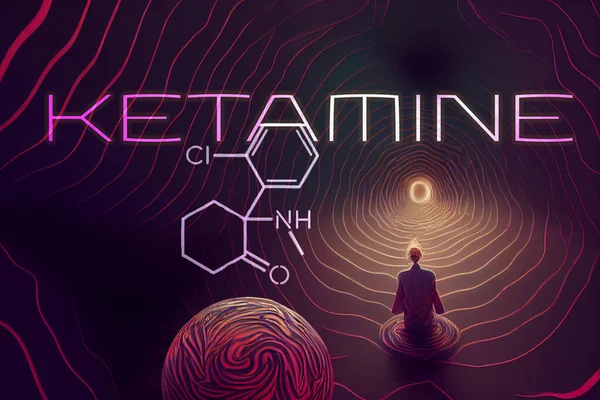Ketamine Therapy / Ketamine-Assisted Psychotherapy (KAP)
Ketamine Therapy: Why work with the medicine?
First of all, not all of our problems can be solved cognitively. Sometimes we need more than words to heal our subconscious wounds and the neurological patterns that control the way we think and feel. Ketamine therapy is useful when talk therapy alone is not enough to free us from the negative thoughts, feelings or behaviors that hijack our lives. Whether it is a persistent depression, an unshakable anxiety, or uncontrollable reactions to trauma triggers, ketamine therapy offers a unique and powerful means to work through deep subconscious programming that lies beyond our conscious cognitive processing.
Secondly, sometimes the source of our pain is known. Other times it occurred at an age that is too young for us to remember. Unable to work directly on the wound, we may start to wonder, “Is there any hope for me?” Ketamine therapy allows us to access with these buried wounds and heal them at the subconscious level.
Finally, ketamine therapy enables us to access a deeper existential appreciation for, and understanding of life. It connecting us to a more spiritual understanding of love, loss and mortality. So if you are facing a terminal illness or have recently lost someone dear to your heart, if life feels empty and gray, and you start to wonder, “what’s the point of carrying on?”, then ketamine can show you the way.
Ketamine: The Medicine
Ketamine is a safe and legal medication. It is currently the only federally approved psychedelic medicine. Ketamine was originally approved as an anesthesia, and is now used in conjunction with psychotherapy to treat clients with a variety of psychological conditions. I offer ketamine-assisted psychotherapy to address: depression, anxiety, PTSD, relationship and attachment issues, existential issues, and psychological issues related to life-treating illness or loss of a loved one.
Ketamine: The Neurological Effect
Ketamine has shown the ability to stimulate both rapid neuron growth and regeneration in the brain. It has also shown to activate the formation of new neural pathways in the brain. In particular, scientists are studying the effects of ketamine (and other psychedelics) on the default mode network (DMN) of the brain. The default mode network is active when people are thinking about themselves, others, the past or the future. The functioning of this network becomes more rigid and fixed as we age. It has been found to be overactive in people suffering from depression and anxiety.
One major contributing factor to its effectiveness is that ketamine has the ability to “turn off” our habituated neural patterns. Additionally, ketamine stimulates new neural connections in the brain. In contrast, medications like SSRI’s only inhibit neural functioning. Hence the need to take these medication daily. By turning off old patterns and stimulating new neurological wiring, the goal of ketamine is healing via neurological change.
In addition to the effects on the DMN, Ketamine therapy is also a powerful tool for accessing and working with (non-cognitive) primary consciousness. Working with non-cognitive consciousness is particularly useful in healing non-cognitive wounds such as trauma and attachment wounding.
Read more about primary consciousness
Ketamine Therapy: The Benefits
In addition to reduction of psychological symptoms of depression, anxiety, and trauma, some of the long term benefits of ketamine therapy include:[/vc_column_text]
- Decreased negativity, obsessive self-criticism, and pessimistic thinking
- Increased self-esteem, self-respect, and self-efficacy
- Decreased stress and fatigue
- Decreased addictive cravings and behaviors
- Calmed chronic hypervigilance
- Decreased reactivity
- Decreased existential anxiety/fear/dread
- Increased cognitive and emotional flexibility
- Developed greater sense of discernment and ability to evaluate situations
- Increased sense of trust in self and others
- Increased ability to have compassion for self and others
- Profound shifts in self-concept, world views, and spirituality
- Increased creativity and motivation
- Increased capacity for joy, appreciation, and optimism

Ketamine therapy: Psycolytic versus Psychedelic Doses
Ketamine therapy or Ketamine-assisted psychotherapy can range from low to high doses of ketamine. A psycolyitc, or low dose of ketamine, creates a relaxed trance-like state. In this state the client typically experiences a mild dissociation, a lowering of psychological defenses, and an empathogenic state of being (a state of connectedness, oneness and emotional openness). At this dose ketamine has an antidepressant effect as well as the ability to free a client from feeling “stuck” in obsessive, anxious, or negative ways of thinking about themselves or the world.
In this state, ketamine helps clients see things from new perspectives and allows them to explore beliefs, memories, and self-concepts from a healthier vantage point. At the lower doses clients can also remain more verbally engaged with the therapist in exploring psychological material.
A moderate dose of ketamine, or a psychedelic dose, can create a deeper trance state in which the client experiences more dissociation, an expansive sense of self, or altered experiences of reality. With high doses of ketamine people may experience full dissociation, traveling out of their body or leaving the physical realm to a transpersonal or mystical state which may include ego-dissolving experiences. In these non-ordinary states of consciousness (NOSC), past content from one’s life may enter into awareness. Additionally, abstract or symbolic content may emerge and get processed on a non-cognitive level. At these higher doses of ketamine, clients are doing more “inner journey work” with less verbal interaction with the therapist.
Ketamine Therapy: Who determines the dose?
A medical doctor who specializes in working with ketamine will prescribe the range for the sizes of doses that can be used during the ketamine therapy sessions. You and I can then discuss how to work within these prescribed ranges, depending on your goals and the type of experience you are seeking.
Initially, ketamine therapy can feel scary fear or anxiety producing for someone who is unfamiliar with non-ordinary states of consciousness or fears “losing control.” This is a normal fear. Part of the preparation before and during a ketamine therapy session is to create a safe space and secure connection with the therapist from which to enter into the more abstract and symbolic psychedelic state. Additionally, the dose of ketamine is typically increased slowly from the first session to the last to help clients learn to “navigate” the psychedelic state.
What does the process look like?
Step One: Free Consultation
Ketamine-assisted psychotherapy begins with a free phone consultation to discuss 1) your interest in working with the medicine, 2) what has led you to the decision to explore ketamine therapy as a treatment option, and 3) any general questions you may have about ketamine therapy and my practice. Working with ketamine and non-ordinary states of consciousness is a big commitment and the sense of connection between you and your therapist is an important part of the process. So part of the free phone intake is for you to make sure that before you feel comfortable working with me as your therapist.
Step Two: Medical Intake
Ketamine is a (FDA) Schedule III medication and therefore you will need to get a prescription from a medical physician. I work with a group of medical providers called Skylight Psychedelics. After completing their online medical intake forms (also free) to insure that there aren’t any medical issues that would make it unsafe for you to use the medicine, you will have a virtual intake session with one of their physicians to review your medical documents, ensure that there aren’t any contraindications for you to participate in ketamine-assisted psychotherapy, and answer any medical questions you have about the medicine.
If approved, Skylight Psychedelics will send your prescription to their pharmacy. The pharmacy will then contact you before mailing the ketamine directly to you.
In addition to the medical intake, Skylight Psychedelics offers additional services for clients such as:
- Providing access to their medical team to answer any other questions or concerns you may have after the initial visit.
- The option of participating in their psychedelic integration yoga as part of your integration process.
- The ability to download a copy of their Integration Handbook.
- Discounts for clients who choose to do additional sessions beyond the standard six-session protocol.
Go to Skylight Psychedelics’ Website
Step Three: Preparatory Sessions
Once you have been approved by a licensed medical provider, we will schedule 2-4 preparatory sessions to further discuss any questions or concerns you might have about ketamine therapy. We will also discuss intention setting, environmental considerations, expectations, safety protocols, and how to prepare yourself for the ketamine sessions.
An important thing to understand about working with ketamine is that the unconscious is highly influenced by one’s mind set and the environmental setting while on the medicine. Taking the time to consciously and mindfully prepare your “set and setting” is an important step of the process. The number of session is determined by amount of preparation you will personally need to feel comfortable and confident in the intentions you have for engaging in ketamine therapy.
Step Four: Ketamine Therapy Sessions
Ketamine-assisted psychotherapy is typically conducted for six sessions over the course of two to three weeks. (This structure is recommendation, not a requirement.) Each session is three hours long. The sessions begin with checking in about any remaining thoughts or concerns and setting the final intention for the journey. After self-administering the medication, the “peak experience ” of the ketamine journey lasts for 40 to 60 minutes. During the coming down phase of the session, we will be able to process your experience and begin to discuss how to integrate your experience.
Step Five: Integration
Integration is a key part of the ketamine-assisted psychotherapy process. I offer integration sessions to assist in this work. It is also important for you to explore integration activities at home. The potential for discovering new insights and laying down new neural connections from a ketamine therapy session can last for days after the medication has left your system. Finding ways to integrate your ketamine journey back into your life will help expand and reinforce whatever new experiences or insights you discovered.
Integration can also be done as part of your work with another psychotherapist. I recommend that you have a personal psychotherapy if you want to do deep work or trauma work with Ketamine.
Ketamine Therapy: Research Studies
Constructing drug effects: A history of set and setting
Ketamine Assisted Psychotherapy: A Systematic Narrative Review of the Literature
Paradigms of Ketamine Treatment
Get In Touch
